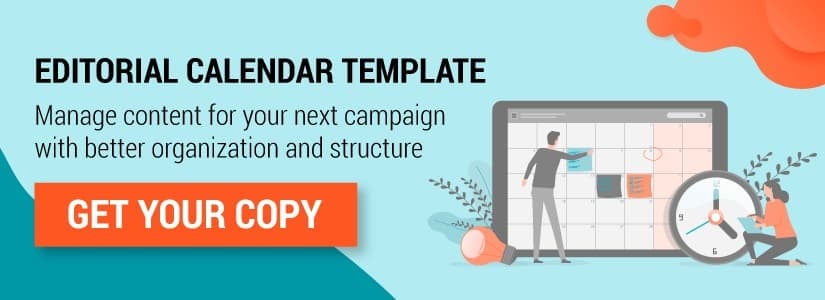Writing a blog for your school’s website is a great way to generate traffic, drive prospects to school events, and increase outreach overall. Publishing content on a regular basis, however, requires a great deal of organization and structure.
Without the proper plan, the chances of actually achieving your content goals drastically decrease.
That’s why we recommend schools utilize an editorial calendar to manage, organize, and structure content for campaigns. In this article, we take a deep dive into each feature of an editorial calendar and how it can maximize your content marketing efforts overall.
Maximize your content with our editorial calendar template!

What is an editorial calendar?
Simply put, an editorial calendar keeps track of your content in a centralized place. Typically, that includes blogs, or other promotional materials, such as videos and content offers. This visual workflow keeps content organized and structured for editors and content creators as well.
How to Create an Editorial Calendar for your School
Editorial calendars will vary based on the specific needs and goals of an organization, in this case, a school. Below are some tips to help create your school’s editorial calendar and keep your content organized in one place.
For the purpose of this article, we take a look at creating an editorial calendar specifically for schools. For a how-to guide on creating a standard editorial calendar, be sure to reference our blog post here.
Additional Resources:
- How to Create an SEO-Driven Editorial Calendar for your Blog
- What is an Editorial Calendar? [And Why You Need One]
1. Identify the Theme of your Campaign
In general, blogging efforts tend to perform better when focusing on a single, organized theme. Considering school’s have unique events throughout the year, we recommend planning for content in terms of quarterly campaigns.
The focus of this campaign will influence your keyword research and the kind of content you create. In essence, your campaign’s theme will have the greatest influence and appeal to your targeted audience. With schools, that includes prospective parents and students. Ultimately, your theme should identify with their challenges and goals.
2. Conduct your Keyword Research
Once you know your campaign’s theme, it’s critical to conduct keyword research. This is where you analyze the search terms your prospect’s are entering into search engines.
Keyword research should also be directly related to your campaign and should focus on answering the questions your prospective student or family would ask.
For example, common questions for a prospective student/family may include:
- What are the benefits of attending an independent school?
- Which school will be best for my child?
- How should parents compare schools?
- How can I make sure my child gets into a good college after they finish high school?
- What should I be looking for during an open house or admissions interview?
Ultimately, your goal in keyword research is to determine the user intent for your prospects when they search for information. By conducting the proper keyword research, the content you create will have valuable search volume to rank organically and grow overall outreach.
3. Create Headlines
Headlines should include your targeted keyword, but should also be interesting to your prospective families or students. When it comes to creating effective content, headlines are arguably the most important aspect of your article. On average, only 20% of readers who view your headline will click through to the article—meaning poor headlines lose 80% of your potential audience.
Conversely, if a headline is effective and gains the reader’s attention, web traffic can increase by as much as 500%. With that, it’s no secret why headlines are a critical component to your campaign.
So, by using the keyword research examples from above, the headlines for a prospective parent or student may include:
- XX (number) Benefits of Attending an Independent School
- What I learned from attending an Independent School
- The best way to compare schools
- XX (number) of Common College Application Mistakes and How to Avoid them
- A Checklist for your First Open House Tour
Remember, the best headlines are creative, but ultimately offer a solution to a challenge or pain point your persona may be experiencing. Bringing together your keyword research to establish an effective headline is imperative to the success of a school marketing campaign.
4. Download Editorial Calendar Template
Before we mention the details of an editorial calendar, download a copy of our template here. This is where you’ll keep track of your content efforts by filling-in each row.
The topics may vary depending on the school’s background, however, these categories provide a general outlook for an effective, transparent calendar.
- Targeted Keyword – What is the keyword you want this article to rank organically? Reference other competing, high ranking articles to help with your keyword research.
- Blog Article/Title Idea – What is the working blog post headline for the targeted keyword?
- Supported Grade/Division/Program – What academic program or school division is this content in support of? Specify what program this is for so that everyone knows who the article is intended for.
- Campaign Name – What campaign is this content for?
- Journey Stage – This correlates to the stage of the journey your prospect is currently on (awareness, consideration, decision). Typically, content in the awareness stage focuses on answering questions, while consideration stage content compares options, and decision stage content focuses on providing solutions for your persona’s challenges.
- Author – Who is writing the content?
- Editor – Who will be editing the content?
- Stakeholder – This is the person who will sign-off on the content and review when it’s done. The stakeholder can also be a point of reference for an author if they have any questions when writing the content itself.
- Published As – Whose name will the article be published under? Ideally, this should be the real name of someone working in the school community (admission officers, professors, principle, etc.)
- Draft Deadline – This is the draft due date for the author.
- Publish Date – What is the date the blog post will go live on the website? We typically recommend alloting two weeks between the draft date and publish dates to review edits or make changes. It should be noted, however, that your team should determine a cadence that works best for reviewing content in your campaign.
- Last Modified Date – This field will reflect the dates when you made changes to content, as edits will often need to be made to blog posts, especially for posts highlighting annual events.
- Status – Simply denotes whether something is planned, in-progress, in-review, etc.
- Published URL – Indicates where your blog post will live on the website once it’s posted. This also makes it easy for your marketing team to find and/or search for.
- Targeted Persona – Who is the person this content is geared towards? For a school, this could include a prospective parent or student. The targeted persona depends on what questions are being answered, who’s asking them, and the general language of the post.
- Content Offer – For a blogging campaign to be effective, we recommend that each blog post is paired with a content offer. Simply put, this is a piece of content we believe the targeted persona would want to download. The strategy here, is that by offering something behind a gate or form on your website, you can prompt the reader to identify themselves with their contact information, at which point you can begin to specifically market to them. Some examples of content offers could include e-books, checklists, worksheets, guides. The more closely aligned your content offer is to the campaign and to the focus of the blog post, the more likely it will lead to conversions.
- Notes – Any and all relevant information during the planning stage can be placed in this column.
Start Planning Your Content Through an Editorial Calendar
By downloading our editorial calendar template, you can be well on your way to scheduling blog posts that are calculated, structured, and measurable. The purpose of an editorial calendar is to work as a central hub for all of your content efforts.
Creating effective content for a school requires input from many different people that, in most cases, have little time to dedicate to specific marketing efforts. That’s why employing a service to help with your content efforts is critical to overall success.
In the end, your school marketing campaign simply cannot afford to create content without an editorial calendar. Any structured, measurable results must be organized, especially in a school setting where several moving pieces are constantly collaborating to achieve a common goal.









